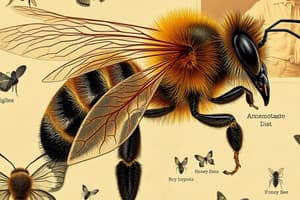Podcast
Questions and Answers
Which genus do honeybees belong to?
Which genus do honeybees belong to?
- Apis (correct)
- Insecta
- Apidae
- Hymenoptera
What is a notable feature of the Western honeybee (Apis mellifera)?
What is a notable feature of the Western honeybee (Apis mellifera)?
- It is known for its large size.
- It demonstrates significant phenotypic plasticity. (correct)
- It has the least honey production compared to other species.
- It builds nests exclusively on tree branches.
What distinguishes Apis cerana from Apis mellifera?
What distinguishes Apis cerana from Apis mellifera?
- It is primarily found in Africa.
- It is the dominant honeybee in Europe.
- It produces significantly larger amounts of honey.
- It is more resilient to Varroa mite infestation. (correct)
Which species of honeybee is noted for building nests on natural surfaces like rock faces?
Which species of honeybee is noted for building nests on natural surfaces like rock faces?
Which of the following is true about Apis florea?
Which of the following is true about Apis florea?
Why is understanding the systematic position of honeybees important?
Why is understanding the systematic position of honeybees important?
What is a characteristic of the Eastern honeybee (Apis cerana)?
What is a characteristic of the Eastern honeybee (Apis cerana)?
Which characteristic is common across all honeybee species within the genus Apis?
Which characteristic is common across all honeybee species within the genus Apis?
Flashcards
Honeybee Classification
Honeybee Classification
Honeybees belong to the animal kingdom, Arthropoda phylum, Insecta class, Hymenoptera order, Apidae family, and Apis genus.
Honeybee Social Structure
Honeybee Social Structure
Honeybees have a well-organized social system with specialized roles like queen, worker, and drone.
Western Honeybee
Western Honeybee
The most common honeybee species (Apis mellifera) known for honey production and pollination.
Eastern Honeybee (A. cerana)
Eastern Honeybee (A. cerana)
Signup and view all the flashcards
Giant Honeybee (Apis dorsata)
Giant Honeybee (Apis dorsata)
Signup and view all the flashcards
Little Honeybee (Apis florea)
Little Honeybee (Apis florea)
Signup and view all the flashcards
Honeybee Communication
Honeybee Communication
Signup and view all the flashcards
Honeybee Variation
Honeybee Variation
Signup and view all the flashcards
Study Notes
Systematic Position of Honeybees
- Honeybees belong to the animal kingdom, phylum Arthropoda, class Insecta, order Hymenoptera, family Apidae, and genus Apis.
- Different species of honeybees exist within the Apis genus.
- Key characteristics distinguishing honeybees from other insects include:
- Presence of a well-developed social structure.
- Specialized roles within the colony (e.g., queen, worker, drone).
- Unique foraging behavior and communication through the "waggle dance."
Species of Honeybees
- Several species of Apis are recognized, with varying characteristics:
- Apis mellifera (Western Honeybee):
- The most widely distributed species, with various subspecies.
- Known for its honey production and pollination services.
- Demonstrates significant phenotypic plasticity, adapting to diverse environmental conditions.
- Apis cerana (Eastern Honeybee):
- Invasive species
- Native to Asia.
- Unique tolerance to certain pathogens compared to A. mellifera.
- More resilient to the Varroa mite infestation, but exhibits less honey storing capacity as compared to Western honeybees
- Apis dorsata (Giant Honeybee):
- Found in Southeast Asia
- Large size.
- Notable for its nest building on natural surfaces, like rock faces, tree branches, and cliffs.
- Strong foraging behaviour.
- Apis florea (Little Honeybee):
- Smallest honeybee species
- Found in tropical regions of Asia
- Nest building includes making small and compact nests usually in low-lying branches or other similar structures in the open air.
- Foraging behaviours vary significantly as compared to other honeybees.
- Apis mellifera (Western Honeybee):
Additional Notes
- Understanding the systematic position is crucial for comparative studies and evolutionary interpretations.
- Variations in species characteristics, foraging behaviour, and physiological adaptations have significant biological and agricultural implications.
- Conservation efforts are needed to maintain genetic diversity of various species within the genus Apis.
Studying That Suits You
Use AI to generate personalized quizzes and flashcards to suit your learning preferences.




